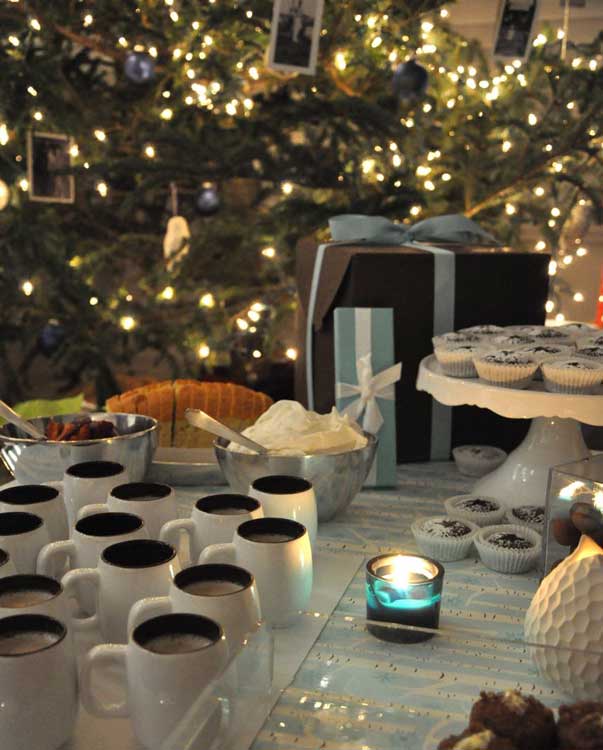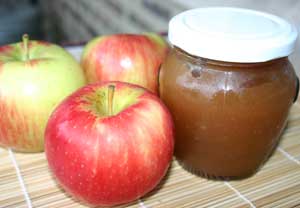
On New Year’s Eve, the Husband and I attended a fabulous potluck dinner (replete with optional 80s themed attire and a not-for-kids gift exchange). Naturally, we brought dessert. Because it’s a long night, I thought it would be fun to get people up and moving around rather than serve dessert at the table. Because there was going to be a crowd, I made everything self-serve and where possible, in individual portions. And it was a success! People grazed and nibbled between after-dinner gift grabbing and midnight toasting. Snaps to Matt for the awesome photos.
Here’s what I made:

1. Tiny dark chocolate whiskey cupcakes, inspired by a December NY Times article about the brilliant holiday tradition of pairing booze with cake. The Husband made me a stencil taped to a paper clip to create the star design.
Tiny dark chocolate whiskey cupcakes (makes 48)
2 c. all-purpose flour
1 t. baking soda
1/2 t. kosher salt
5 oz. unsweetened chocolate (use a good one)
1/4 c. instant espresso powder
2 T. (generous) unsweetened cocoa powder
1 c. whiskey, plus more for sprinkling and a belt for the chef
1 T. vanilla extract
1/2# unsalted butter, softened
2 c. sugar
3 eggs
– Line mini cupcake pans with papers (or butter and flour a tube pan, 2 loaf pans, or paper for 12 regular-sized cupcakes). Preheat oven to 325F.
– Melt the chocolate in the microwave or in metal bowl over simmering water; let cool.
– Put espresso and cocoa in a 2-cup glass measuring cup and add enough boiling water to make 1 cup, mix til combined. Add whiskey and vanilla and let cool.
– Sift together flour, salt, and soda in a small bowl.
– Using a stand mixer with the paddle attachment, beat butter until fluffy. Add sugar and beat until very fluffy. Add eggs one at a time, beating well between each addition. Beat in melted chocolate. Scrape the sides of the bowl to make sure all ingredients are combined.
– On low speed, beat in a third of the whiskey mixture. When liquid is absorbed, beat in half of the flour mixture. Repeat alternating additions, ending with whiskey. Most things do. Scrape batter into prepared pan(s) and smooth the top. Bake until a cake tester inserted into center of cake comes out clean (tiny cupcakes are done in 15 minutes, the tube pan takes about 1 hour).
– Transfer cake to a rack. Unmold after 15-20 minutes and brush warm cake with the extra whiskey. Brush it again if you like things boozy. Be sure the cake is absolutely, completely cool before sprinkling with powdered sugar. Wrapped tightly, this cake freezes well…but needs to be brought to true room temperature to get the full effect of the booze+chocolate combo.
2. Truffles infused with dried-cherry balsamic syrup, using a recipe found on Design*Sponge, which is about as addictive as the truffles. These are so easy and so decadent.
Truffles infused with dried-cherry balsamic syrup
8 oz. dark chocolate, chopped (as always, spring for the best you can afford)
¼ c. heavy cream
pinch of salt
2 T. balsamic vinegar
8-12 dried cherries
½ c. cocoa powder (don’t even think of using Hershey’s)
– Heat the cherries and vinegar in a small saucepan and simmer for 5 minutes. Drain, reserving the liquid. Save the cherries for nibbling with a stinky and/or creamy cheese or as an addition to a salad of bitter greens (seriously intense, seriously good).
– Heat the chocolate and cream in a metal bowl over a pan of simmering water. Stir gently until smooth. Remove from heat. Stir in cherry-balsamic syrup. Cover the bowl with plastic wrap and set aside until firm enough to shape. This can take a couple of hours…I usually make the truffle mixture in the morning and then roll them at night or even the next morning. If you’re in a hurry, chill the mixture but not too much! You want something that feels slightly harder than Play Doh, because the heat from your hands will melt things once you start rolling. But too much refrigeration can leave you with a rock-solid chunk.
– To shape the truffles, scoop out a small nugget with a teaspoon and quickly roll between your palms to form a ball. I prefer truffles that are small, one-bite size. Roll them into the cocoa powder. That’s it! Store at room temperature in an airtight container for up to 2 weeks (as if).
3. Pound cake with macerated strawberries and whipped cream, an old favorite. Reports of a post-midnight “incident” involving the whipped cream have not yet been verified.
Pound cake with macerated strawberries and whipped cream
for the cake:
2 c. all-purpose flour
1 t. baking powder
1/2 t. salt
1/2# unsalted butter, softened
1 c. sugar
4 eggs at room temperature
2 t. vanilla extract
– Preheat oven to 325F. Butter and flour a loaf pan.
– Whisk together flour, powder, and salt.
– In a stand mixer with the paddle, beat butter and sugar until super fluffy, at least 5 minutes. Add eggs one at a time, beating well after each addition. Add the vanilla. Scrape the sides of the bowl to make sure all ingredients are combined.
– Add the flour mixture all at once and beat at low speed until just combined. Don’t overdo it! Use your rubber scraper to blend in the stuff from the sides and bottom of the bowl.
– Scrape into the pan, smoothing the top. Bake for until a cake tester comes out clean, at least an hour. If the top browns to quickly, loosely cover the pan with foil. Let the cake cool on a wire rack until cool, then unmold. This cake freezes well.
for the strawberries:
2 pints strawberries
2 T. sugar
2 T. balsamic vinegar
– Rinse, hull and quarter the berries. Toss with sugar and balsamic. Let sit up to an hour. Drain the liquid into a small saucepan. Simmer until slightly thickened. When cool, pour the syrup back over the berries.
for the whipped cream:
1 c. heavy whipping cream
1 t. vanilla extract
2 T. powdered sugar
– Beat it all in a large bowl with a whisk until thick and slightly stiff. Ideally, the bowl is chilled. If your arm gets tired, ask Kyle to help you.

4. Coffee panna cotta made in individual demitasse cups. Usually I make panna cotta in custard cups and unmold them right before serving. This version works well, too, with the coffee syrup at the bottom of the cup adding a nice surprise. The blue and white paper on the table is by Snow & Graham.
Coffee panna cotta
1/4 c. strong coffee (a shot of espresso works well)
1/4 c. sugar
– Combine coffee and sugar in a small saucepan and simmer until syrupy, about 5 minutes. Transfer to a glass measuring cup and allow to cool. Pour into 6 demitasse cups, distributing evenly.
1 t. gelatine
1 T. whole milk
– Sprinkle gelatine over milk in a small bowl and allow to stand for a few minutes, until it’s puckery.
1 c. table cream
1 c. whole milk
1/3 c. powdered sugar
1 t. vanilla extract
– Combine cream, milk, sugar, vanilla in a saucepan and heat to boiling. Remove from heat and whisk in the gelatine mixture. Transfer to a glass measuring cup, llow to cool. Pour into the demitasse cups and refrigerate at least 6 hours or be smarter than I was and chill these babies overnight.











